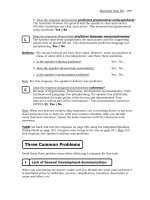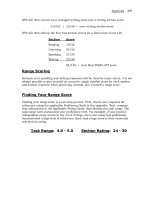Pre-Reading Strategies
Bạn đang xem bản rút gọn của tài liệu. Xem và tải ngay bản đầy đủ của tài liệu tại đây (103.39 KB, 16 trang )
13
CHAPTER
1
P
RE
-R
EADING
S
TRATEGIES
Reading success depends
upon your active
participation as a reader.
This chapter will
show you how to use
pre-reading strategies to
“warm up” to any
reading task.
T
he difference between a good reader and a
frustrated reader is much like the difference between an athlete
and a sports fan: the athlete actively participates in the sport
while the fan remains on the sidelines. A good reader is always actively
engaged in the reading task. Frustrated readers, on the other hand, think
of reading as a passive “sideline” task, something that doesn’t require
their active participation. As a result, they often have difficulty under-
standing and remembering what they read.
Perhaps the most important—and most basic—thing you can do to
improve your reading skills is to get off the sidelines and become an
READ BETTER
,
REMEMBER MORE
14
active reader. This doesn’t mean you should work up a sweat while read-
ing, but it does mean that you should be actively involved with the text
whenever you read.
To become an active reader, it helps to think of
reading as a dialogue where you talk with the writer,
not a one-way conversation where you just sit back
and let the writer talk at you. When you talk with
people, you nod, talk back, and ask questions. You
watch the facial expressions and gestures of the speak-
ers and listen to their tone of voice to help you under-
stand what they’re saying. Active readers apply these same strategies to
reading. The chapters in this book will show you exactly how to do that.
In this chapter, you will learn effective pre-reading strategies that you
can use to prepare for reading tasks. Just as athletes enhance their perfor-
mance by stretching before they go out on the court or field, active read-
ers can significantly increase how much they understand and remember
if they take a few minutes to “stretch” before they read.
Here are three pre-reading strategies that will dramatically improve
your chances of reading success:
1
. breaking up the reading task
2
. reading the pre-text
3
. skimming ahead and jumping back
BREAK IT UP INTO MANAGEABLE TASKS
The first step you can take as an active reader is to plan a strategy for your
reading task. Readers sometimes get frustrated because the reading task
before them seems impossible. “A hundred pages!” they might say. “How
am I going to get through this? How am I going to remember all this?”
Building a skyscraper or renovating a house may seem like an impos-
sible task at first, too. But these things get accomplished by breaking the
whole into manageable parts. Buildings get put up one floor and one
brick at a time; houses get renovated one room and one section at a
time. And reading gets done in the same way: little by little, piece by
piece, page by page.
Thus, one of your first strategies should be to break up your reading
into manageable tasks. If you have to read a chapter that’s 40 pages long,
Be an Active Reader
You’ll understand and
remember more if you
become an active reader.
PRE
-
READING STRATEGIES
15
can you divide those 40 pages into four sections of 10 pages each? Or is
the chapter already divided into sections that you can use as starting and
stopping points?
In general, if the text you’re reading is only a few pages (say, less than
five), you probably don’t need to break up the task into different reading
sessions. But if it’s more than five pages, you’ll probably benefit from
breaking it into two halves. If you find the first half goes really well, go
ahead—jump right into the second. But you’ll feel more confident know-
ing that you can take it one section at a time.
The Benefits of Starting and Stopping
By breaking up a text into manageable tasks, you do more than just
reduce frustration. You also improve the chances that you’ll remember
more. That’s because your brain can only absorb so much information in
a certain amount of time. Especially if the text is filled with facts or ideas
that are new to you, you need to give yourself time to absorb that infor-
mation. Breaking the reading into manageable tasks gives you a chance to
digest the information in each section.
In addition, simply because of the way the human mind works, people
tend to remember most what comes first and what comes last. Think about
the last movie you saw, for example. If you’re like most people, you can
probably remember exactly how it began and exactly how it ended. You
know what happened in the middle, of course, but those details aren’t as
clear as the details of the beginning and the end. This is just the nature of
the learning process. Thus, if you break up a reading task into several
sections, there are more starting and stopping points—more beginnings
and endings to remember. There will be less material in the middle to be
forgotten.
Scheduling Breaks
Part of breaking up a reading task means scheduling in breaks. If you’ve
divided 40 pages into four sections of ten pages each, be sure to give
yourself a brief pause between each section. Otherwise, you lose the ben-
efits you’d get from starting and stopping. Perhaps you can read ten
pages, take a five minute stretch, and then read ten more. You might do
the same for the other 20 pages tomorrow.
READ BETTER
,
REMEMBER MORE
16
Use Existing Section Breaks
Writers will often help you learn and remember information by dividing
the text into manageable chunks for you. Page through this book, for
example, to see how it breaks up information for you. Notice that the
book is divided into sections; the sections are divided into chapters. The
chapters are then divided into summaries, main strategies (indicated by
the headings, or subtitles), practice exercises, answers, a review, and skill
building strategies. All you need to do is decide how many chunks you’ll
read at a time.
P
RACTICE
1
Keeping in mind your optimum concentration time, develop a strategy for
reading this book. Will you do one chapter each day? Complete each chap-
ter in one sitting? Will you read the chapter in the morning and do the
exercises in the evening? Write your strategy on a separate piece of paper
and keep it in the front of this book.
Answer
Answers will vary, depending upon your preferences and personality.
Here’s one possible reading plan:
•
Read one chapter each day, Monday through Friday.
•
Reading time: 8:00–8:30, right after breakfast. (I can’t concentrate
on an empty stomach.)
•
Reading place: At the kitchen table. I can spread my books and
papers out, the light is bright, and it’s usually quiet.
•
Music: I’ll turn on the classical radio station—the public station
that doesn’t have commercials (which really distract me). The soft
music will help me relax and drown out the hum of traffic.
•
Other: I must put the newspaper aside until after I finish my chap-
ter. I’ll save reading the paper as a “reward.”
READ THE PRE-TEXT
Writers generally provide you with a great deal of information before they
even begin their main text—and this information will often help you
better understand the reading ahead. For example, look at this book. Its
cover provides you with a title and lists some of the features of the book.
PRE
-
READING STRATEGIES
17
Inside, on the first few pages, you get the author’s name and some infor-
mation about the publisher. Then comes the table of contents and general
introduction and guidelines for how to use this book. Each section has its
own introduction, and each chapter begins with a short summary.
Each of these features fall into a category called pre-text. Information in
the pre-text is designed to help you better understand and remember what
you read. It tells you, in advance, the main idea and the purpose of what’s
ahead. Most texts provide you with one or more of these pre-text features:
•
Title
•
Subtitle
•
Biographical information about the author
•
Table of contents
•
Introduction or preface
•
Section summary
Each pre-text feature tells you information about the writer’s purpose
and the main ideas that the writer wants to convey. By looking at these
reading aids before you begin, you’ll get a clear sense of what you’re
supposed to learn and why. Pre-text features are designed to arouse your
interest, raise your expectations, and make information manageable.
They introduce you to the key ideas of the text and indicate the major
divisions of the text. Reading them will better prepare you to understand
and remember what’s to come.
Athletes who know the purpose of a practice drill will be more moti-
vated and better prepared to do the exercise well. Likewise, you’ll be more
motivated and better prepared to read a text if you’re aware of its purpose
and what you’re about to learn.
P
RACTICE
2
If you haven’t read the pre-text of this book, please STOP working
through this chapter and read the pre-text now. In particular, read
through the Table of Contents and Introduction as well as the summary
of Section 1. Then, answer the following questions:
1
. Why should you do the chapters in order?
2
. What is included at the end of each section?
READ BETTER
,
REMEMBER MORE
18
3
. What two things should you do to improve your chances of reading
success?
4
. What are the chapters in Section 1 about?
Answer
If you’re at all uncertain about the correct answers to this practice exer-
cise, re-read the pre-text. When you find the sentences that have the
answers, underline them.
SKIM AHEAD AND JUMP BACK
Another important pre-reading strategy is skimming ahead and jumping
back. Before you read a section of text, read the summary (if available),
and then skim ahead. Go through and look at the headings or divisions
of the section. How is it broken down? What are the main topics in that
section, and in what order are they covered? If the text isn’t divided, read
the first few words of each paragraph or random paragraphs. What are
these paragraphs about? Finally, what key words or phrases are high-
lighted, underlined, boxed, or bulleted in the text?
Like reading the pre-text, skimming ahead helps prepare you to
receive the information to come. You may not realize it, but subcon-
sciously, your mind picks up a lot. When you skim ahead, the key words
and ideas you come across will register in your brain. Then, when you
read the information more carefully, there’s already a “place” for that
information to go.
To further strengthen your understanding and memory of what you
read, when you finish a chapter or a section, jump back and review the
text. In this book, you are provided with a review at the end of each chap-
ter called “In Short,” but you should also go back and review the high-
lights of each section when you’ve finished. Look back at the headings,
the information in bullets, and any information that’s boxed or otherwise
highlighted to show that it’s important.
You can jump back at any time in the reading process, and you should
do it any time you feel that the information is starting to overload. This
will help you remember where you’ve been and where you’re going. Skim-
ming ahead and jumping back can also remind you how what you’re read-
ing now fits into the bigger picture. This also helps you better understand
and remember what you read by allowing you to make connections and









